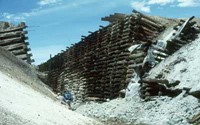Abandoned Mine Lands: Basic Information

Abandoned Mine Lands (AMLs) are:
"Those lands, waters, and surrounding watersheds contaminated or scarred by extraction, beneficiation or processing of ores and minerals, including phosphate but not coal*. Abandoned mine lands include areas where mining or processing activity is temporarily inactive."
EPA's AML Program identifies ways to protect human health and the environment by using all of the non-regulatory and regulatory approaches available to the Agency. These approaches include:
- Voluntary cleanups
- Agency-managed emergency responses
- Involvement of Brownfields partners
- Cleanups based on redevelopment/revitalization
- Agreement on Consent remediation
- Superfund Alternative Site designation
- NPL listing
- Innovative reuse/remediation
To best coordinate the risk reduction and cleanup of abandoned mine lands, the AML Program partners with:
- Other federal land management agencies
- States
- Tribes
- Mine owners and operators
- Community stakeholders
The EPA AML Program is coordinated through the Agency's National Mining Team (NMT) and Abandoned Mine Lands Team (AMLT). These teams provide EPA headquarters and Regional core of expertise on issues at abandoned mine sites. The teams together serve as a focal point for coordinating and facilitating national technical, policy and process issues with stakeholders on abandoned/inactive mine research, characterization, cleanup and redevelopment activities.
*Although acid mine drainage/acid rock drainage caused by coal mining commonly results in significant environmental impacts, Congress has designated the Department of the Interior’s Office of Surface Mining as the federal authority responsible for addressing these coal mining contamination problems.
